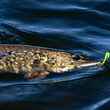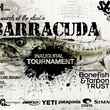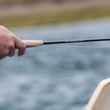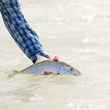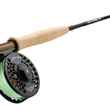Rewind 82 years. It’s 1932.
Ernest Hemingway, with A Farewell to Arms looming as suppressed musings in his mind’s periphery, is perched on a barstool in Sloppy Joe’s Bar sipping a whiskey and coke, conversing with his fishing-minded acquaintances, the salty, blue Atlantic sky beaming in through the open doors. Outside, crystalline saltwater kisses the sandy beaches of Key West; and like so, rumors of elusive, uncatchable, finned, marine beasts filter west from the Bahaman Islands. There is a catalyst in the air, a catalyst for the outbreak of the gilded age of big-game sport fishing, and for a self-made, inventive, American success story.

Frank O’Brien, an industrious man doing his best to make money to support his family during the height of the Great Depression, is selling cutlery on the streets. A fisherman at heart, O’Brien makes the acquaintance of Jack Reynolds, local and owner of Florida Fishing Tackle, a company invested in the sale of small hardware items — hooks, lines, and sinkers. O’Brien partners with Reynolds as a salesman — his trade and talent — and becomes imbued in the saltwater fishing industry.
Thus he came to understand the nature of fishing on the East Coast. Big game fishing was no main stage there — the West Coast held that authority. However, the rumors of large, unconquerable game fish in the Atlantic that awaited Hemingway’s adventurous spirit outside the bar did not escape his attention. In fact, he recognized the shortcoming in heavy tackle to handle such large fish, and made it his personal mission to solve it.
It’s 1934, and Frank O’Brien just split parties with Jack Reynolds and Florida Fishing Tackle. He moves to Miami and establishes a business producing heavy big game rods out of hickory, snakewood, and Tonkin cane, selling them for $150 — $2,600 today.

At the height of the Great Depression, such a sum was steep, unthinkable, to the vast majority, to say the least; but O’Brien’s ingenuity hinged on that concept. Fishermen — more importantly, big game fishermen — in the 30s had money. Lots of it. In fact, an adequate big game rod was preceded on the anglers’ shopping lists by an appropriate offshore boat, gas, matching reels, and a standup crew. When it finally came to choosing a rod, O’Brien’s “Bimini King” rod was the only and best tool on the market; and on that concept, the Tycoon Tackle brand was established.
That very same year, 1934, 90% of world record saltwater game fish caught and registered with the IGFA were fought on Tycoon rods. A short while later, Michael Lerner, an early pioneer of big game fishing and founder of the International Game Fish Association, caught a world record swordfish. Hemingway got to breaking records too — namely boating the first unmutilated marlin —, on his “rod of choice,” the “Bimini King.”
WWII arrived in the year 1942, and the U.S. Government placed an embargo on fishing tackle, effectively converting Tycoon Tackle to wartime supply manufacturing.
After the war ended, O’Brien collaborated with Fred Grieten of Finoor Reels for a short time; but Tycoon Tackle eventually sold out of the incorporation.

Tycoon Tackle’s activity tapered off into the early 70’s and fizzled upon Frank O’Brien’s passing early in the decade. Tim O’Brien, Frank’s son, was in college, distracted, and uninterested at the time in the family business.
Jump back. It’s 2014, and I’m ending my day on a soft note. The stars are out, the crickets and peepers are singing, and I’m standing upright in a canoe, casting to the lily-padded edge of a farm pond silhouetted by the moon against dead calm, reflective water. I have no visual cues to time my fly casting—it’s all feel in the dark. There’s a fiberglass Tycoon Tackle fly rod pulsating rhythmically in my hand.
Tim O’Brien , graduated from college and leading a life as a successful businessman, snatched up the unclaimed Tycoon Tackle trademark several years ago and put Tycoon rods back into production with an expanded repertoire, continuing the family legacy. Behind the name now sits world-renowned rod builders and a prestigious company history.
My popper lands with a splash in the shadow of a bush that I cannot see. I strip twice, and an abrupt splash shatters the silence of the night. I know I’ve got a fish on. Fighting a fish in the dark marries you to the rod—it becomes your eyes. As I hoist a sizeable largemouth from the warm summer water, the scene portrays a story, a faded tradition rekindled, and a future ripe with historical flavor; and I see it all through the cork of the handle.





